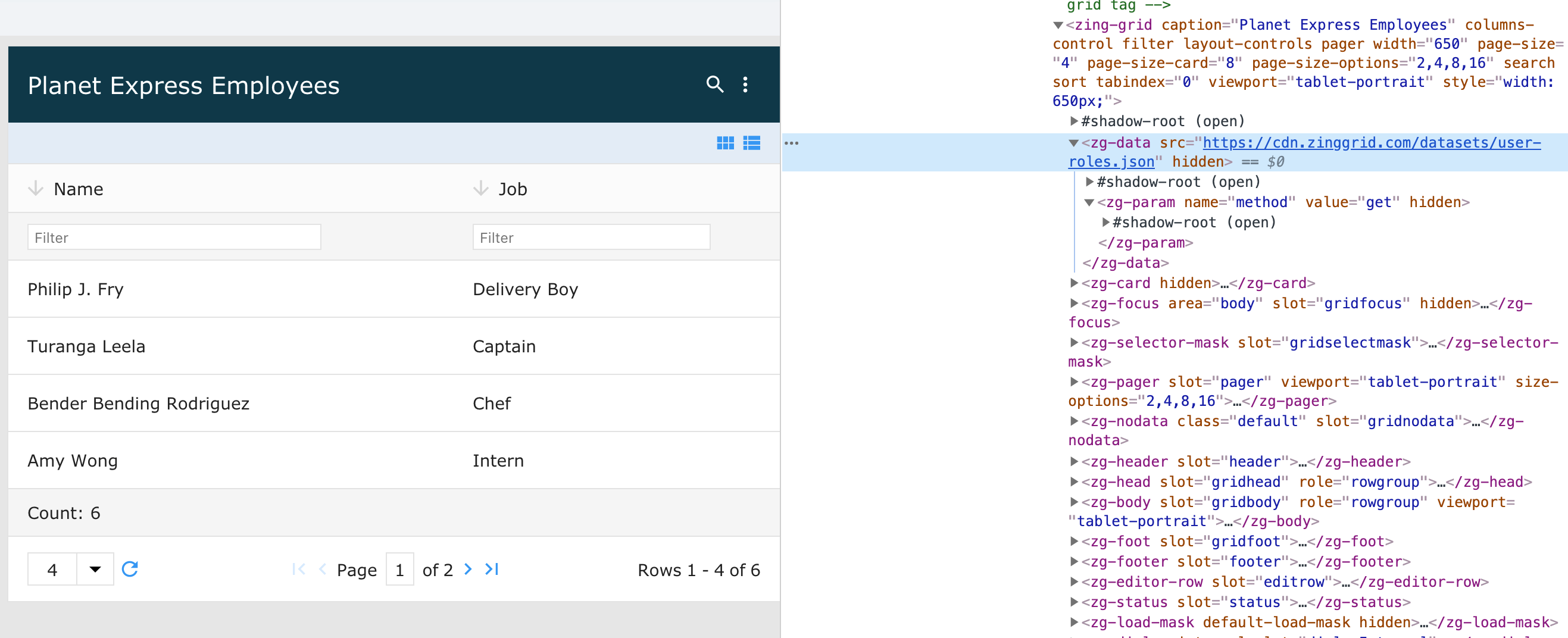<zg-data>
Interactive Storybook Playground
The <zg-data> tag is a web component that controls data associated to the grid. As an non-visual element, you should not apply style to this tag.

Related Web Components
Usage
A <zg-data> tag will always be implicitly used by the grid; when using top level data and src tags, a <zg-data> is created behind the scenes.
<zing-grid src="https://cdn.zinggrid.com/datasets/user-roles.json">
</zing-grid>
The following markup is the same as the HTML above:
<zing-grid>
<zg-data src="https://cdn.zinggrid.com/datasets/user-roles.json"></zg-data>
</zing-grid>
If you have a more complex use case that requires headers and arguments to be passed to the server containing your src, then <zg-data> and <zg-param>(s) will be used. <zg-data>should be employed and various configuration values set via the options attribute, or more appropriately, via <zg-param> tags nested within the tag.
<zing-grid
pager
page-size="5"
layout="row"
layout-controls="disabled"
viewport-stop>
<zg-caption>
ZingGrid Star Wars Server Paging
<span class="button" id="reloadBtn">Reload Demo</span>
</zg-caption>
<zg-data>
<!-- define the main source for the API -->
<zg-param name="src" value="https://swapi.py4e.com/api/people/"></zg-param>
<!-- define the path in the JSON to get the array of results.
In this case it is body.results -->
<zg-param name="recordPath" value="results"></zg-param>
<!-- if loadByPage is set to true it will go to the
server for each new page of data -->
<zg-param name="loadByPage" value="true"></zg-param>
<!-- define the "page" query parameter -->
<zg-param name="pageKey" value="page"></zg-param>
<!-- Need to tell ZG how many records were returned so it knows
how to divide up the page-size -->
<zg-param name="countPath" value="count"></zg-param>
<!-- define the path in the result JSON to find next/prev urls -->
<zg-param name="nextPath" value="next"></zg-param>
<zg-param name="prevPath" value="previous"></zg-param>
</zg-data>
<zg-colgroup>
<zg-column index="name"></zg-column>
<zg-column index="height"></zg-column>
<zg-column index="mass"></zg-column>
<zg-column index="hair_color"></zg-column>
<zg-column index="eye_color"></zg-column>
<zg-column index="skin_color"></zg-column>
</zg-colgroup>
</zing-grid>
Attributes
There are a couple attributes for <zg-data> that are used to create adapters, parameters and arguments when fetching your data source.
Example Usage
<zing-grid>
<zg-data src="https://cdn.zinggrid.com/datasets/user-roles.json"></zg-data>
</zing-grid>
CSS Variables
There are no CSS variables available for the <zg-data> web component.
CSS Selector
As an non-visual element, you should not apply style to this tag.
Slots
<zg-data> contains placeholders to allow adding markup inside the component.
<zg-data><zg-param></zg-param></zg-data>
Below is a list of all the associated ZGData slots. Check out the full list of slots.